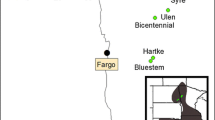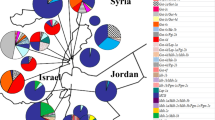Abstract
Aristida stricta Michx. (Poaceae) is a perennial bunchgrass native to the Southeastern Coastal Plain of North America where it is a keystone species in the longleaf pine savannas and slash pine flatwoods from southeastern North Carolina to Florida, and westward to the coast of Mississippi. We examined genetic relationships within and among ten populations of A. stricta by using eight inter-simple sequence repeat (ISSR) markers to generate band frequency data for 32 individuals from each sampled population. An analysis of molecular variance showed that 38% of the variation resided among populations while 62% was attributable to variation within populations. Grouping the populations by habitat or by geographic location did not show significant differentiation between the groups. Overall, pair-wise geographic and genetic distances were not correlated. Data indicate that while individuals within each population are genetically diverse, there seemingly are barriers to gene flow across populations leading to their divergence. Each population contains several exclusive loci suggesting that limited gene flow and/or genetic drift are likely leading to this pattern of localization. Our results, coupled with those of the previous studies that presented evidence for local adaptation and phenotypic differences among populations, suggest that there is sufficient differentiation among populations of this species to warrant: (1) maintenance of the existing genetic diversity at individual sites, and (2) use of local seed and plant sources for conservation projects.





Similar content being viewed by others
References
Archibald JK, Mort ME, Crawford DJ, Santos-Guerra A (2006) Evolutionary relationships within recently radiated taxa: comments on methodology and analysis of inter-simple sequence repeat data and other hypervariable, dominant markers. Taxon 55:747–756
Clewell AF (1989) Natural history of wiregrass (Aristida stricta Michx., Graminae). Nat Areas J 9:223–233
Coffey KL, Kirkman LK (2006) Seed germination strategies of species with restoration potential in a fire-maintained pine savanna. Nat Areas J 26:289–299
Earley LS (2004) Looking for longleaf: the fall and rise of an American forest. The University of North Carolina Press, Chapel Hill, NC
Esselman EJ, Jianqiang L, Crawford DJ, Winduss JL, Wolfe AD (1999) Clonal diversity in the rare Calamagrostis porterii ssp. insperata (Poaceae): comparative results for allozymes and random amplified polymorphic DNA (RAPD) and inter simple sequence repeat (ISSR) markers. Mol Ecol 8:443–451
Evanno G, Regnaut S, Goudet J (2005) Detecting the number of clusters of individuals using the software structure: a simulation study. Mol Ecol 14:2611–2620
Ewens WJ (1972) The sampling theory of selectively neutral alleles. Theor Pop Biol 3:87–112
Excoffier L, Smouse P, Quattro J (1992) Analysis of molecular variance inferred from metric distances among DNA haplotypes—application to human mitochondrial DNA restriction data. Genetics 131:479–491
Excoffier L, Laval G, Schneider S (2006) Arlequin (version 3.1): An integrated software package for population genetics data analysis. Computation and molecular population genetics lab, Institute of Zoology, University of Berne, Switzerland. Available for downloading at http://cpmg.unibe.ch/software/arlequin3
Falk DA, Holsinger KE (1991) Genetics and conservation of rare plants. Oxford University Press, NY
Felsenstein J (2004) PHYLIP: phylogeny inference package (version 3.6) distributed by the author. Department of Genome Sciences, University of Washington, Seattle, WA
George S, Sharma J, Yadon YL (2009) Genetic diversity of the endangered and narrow endemic Piperia yadonii (Orchidaceae) assessed with ISSR polymorphisms. Am J Bot 96:2022–2030. doi:10.3732/ajb.0800368
Godt MJW, Hamrick JL (1995) Allozyme variation in two Great Smoky Mountain endemics: Cacalia regalia and Glyceria nubigena. J Hered 86:194–198
Godt MJW, Hamrick JL (1998) Allozyme diversity in the grasses. In: Cheplick GP (ed) Population biology of the grasses. Cambridge University Press, Cambridge, MA, pp 11–29
Gordon DR, Rice KJ (1998) Patterns of differentiation in wiregrass (Aristida beyrichiana): implications for restoration efforts. Restor Ecol 6:166–174. doi:10.1111/j.1526-100X.1998.00627.x
Hamrick JL (1983) The distribution of genetic variation within and among natural plant populations. In: Schonewald-Cox CN, Chambers SM (eds) Genetics and wild population management. Addison-Wesley, NY, pp 335–348
Hufford KM, Mazer SJ (2003) Plant ecotypes: genetic differentiation in the age of ecological restoration. Trends Ecol Evol 18:147–155. doi:10.1016/S0169-5347(03)00002-8
Kalmbacher R, Norcini J, Pittman T, Pfaff S, Martin F (2004) Wiregrass grown from seeds obtained on Florida flat wood and sandhill sites. Nativ Plants J 5:123–130
Kesler TR, Anderson LC, Hermann SM (2003) A taxonomic reevaluation of Aristida stricta (Poaceae) using anatomy and morphology. Southeast Nat 2:1–10
Kindell CE, Winn AA, Miller TE (1996) The effects of surrounding vegetation and transplant age on the detection of local differentiation in the perennial grass Aristida stricta. J Ecol 84:745–754
Landers JL, van Lear DH, Boyce WD (1995) The longleaf pine forests of the southeast: requiem or renaissance. J For 93:39–44
Lynch M, Milligan BG (1994) Analysis of population genetic structure with RAPD markers. Mol Ecol 3:91–99. doi:10.1111/j.1365-294X.1994.tb00109.x
Mantel N (1967) The detection of disease clustering and a generalized regression approach. Cancer Res 27:209–220
McCay DH (2000) Effects of chronic human activities on invasion of longleaf pine forests by sand pine. Ecosystems 3:283–292. doi:10.1007/s100210000026
McGlaughlin M, Karoly K, Kaye T (2002) Genetic variation and its relationship to population size in reintroduced populations of pink sand verbena, Abronia umbellata subsp. breviflora (Nyctaginaceae). Conserv Genet 3:411–420. doi:10.1023/A:1020507416654
Nei M (1972) Genetic distance between populations. Amer Nat 106:283–292
Orloci L (1978) Multivariate analysis in vegetation research. Dr W. Junk Pub Co, The Hague, p 451
Outcalt KW (1994) Seed production of wiregrass in Central Florida following growing season prescribed burns. Intern J Wildl Fire 41:123–125
Outcalt KW, Williams ME, Onokpise O (1999) Restoring Aristida stricta to Pinus palustris ecosystems on the Atlantic Coastal Plains, USA. Restor Ecol 2:262–270. doi:10.1071/WF9940123
Page RDM (1996) TREEVIEW: an application to display phylogenetic trees on personal computers. Comp Appl Bioscie 12:357–358
Parrott RK (1967) A study of wiregrass (Aristida stricta Michx.) with particular reference to fire. MS Thesis, Duke University
Peakall R, Smouse PE (2006) GenAlEx 6: genetic analysis in excel: population genetic software for teaching and research. Mol Ecol Notes 6:288–295. doi:10.1111/j.1471-8286.2005.01155.x
Peet RK (1993) A taxonomic study of Aristida stricta and A. beyrichiana. Rhodora 95:25–37
Platt WJ (1988) Fire ecology of the southeastern longleaf pine flatwoods. In: Duever LC, Noss RF (eds) Wiregrass biology and management: maintaining groundcover integrity in longleaf. Gainesville, FL. p 5
Pritchard JK, Stephens M, Donnelly P (2000) Inference of population structure using multilocus genotype data. Genetics 155:945–959
Robbins LE, Myers RL (1992) Seasonal effects of prescribed burning in Florida: a review. In: Miscellaneous publication No. 8. Tall timbers research incorporated
Rohlf FJ (2005) NTSYS-pc (version 2.2): numerical taxonomy and multivariate analysis system Exeter Software, Setauket, NY
Smith JF, Bateman TA (2002) Genetic differentiation of rare and common varieties of Eriogonum shockleyi (Polygonaceae) in Idaho using ISSR variability. West N Amer Nat 62:316–326
Streng DR, Glitzenstein JS, Platt WJ (1993) Evaluating effects of season of burning longleaf pine forests: a critical literature review and some results from an ongoing long term study. In: Hermann SM (ed) Proceedings of the tall timbers fire ecology conference no. 18. Tall Timbers Research Station, Tallahassee, FL, pp 227–263
van Eerden BP (1997) Studies on the reproductive biology of wiregrass (Aristida stricta Michaux) in the Carolina sandhills. MS Thesis, University of Georgia
von Trinius CB, Ruprecht FJ (1849) Aristida beyrichiana. Mémoires de ľAcadémie Impériale des Sciences de St. Pétersbourg, Ser. 6, Sciences et Mathématiques, Second Partie, Sciences Naturelles 7:104
Walters TW, Decker-Walters DS, Gordon DR (1994) Restoration considerations for wiregrass (Aristida stricta): allozymic diversity of populations. Conserv Biol 8:581–585
Ward DB (2001) New combinations in the Florida flora. Novon 11:360–365
Watterson G (1978) The homozygosity test of neutrality. Genetics 88:405–417
Yeh FC, Yang RC, Boyle T (2000) POPGENE ver 1.32, Microsoft Windows-based freeware for population genetic analysis, University of Alberta and the Centre for International Forestry Research. Available from: (http://www.ualberta.ca/~fyeh/)
Zietkiewicz E, Rafalski A, Labuda D (1994) Genome fingerprinting by simple sequence repeat (SSR)-anchored polymerase chain reaction amplification. Genomics 20:176–183. doi:10.1006/geno.1994.1151
Acknowledgments
This research was supported by grant R-003-07 from the Florida Wildflower Foundation. We are grateful to the following individuals for providing permits, collecting leaf tissue, and/or providing technical or logistical assistance: Susan Cohen (Marine Corps Base Camp LeJeune, NC); Allynne Askins (Carolina Sandhills National Wildlife Refuge, SC); Kay Kirkman and Melanie Keiser (Joseph W. Jones Ecological Research Center, GA); Rob Sutter and Chuck Martin (The Nature Conservancy, Moody Forest Natural Area, GA); Stephen Lee and Mark Garner (Conecuh National Forest, AL); Durwin Carter (Grand Bay National Wildlife Refuge, MS); Mike Keys (St. Marks Wildlife Refuge, FL); Chris Matson (The Nature Conservancy, Disney Wildlife Preserve, FL); Brian Scofield and Mike Kemmerer (Babcock-Webb Wildlife Management Area, FL); Rebecca Riddle (UF NFREC, Quincy, FL), and Fé Almira (UF, Gainesville, FL). Doria Gordon (The Nature Conservancy, University of Florida) contributed invaluably to the manuscript.
Author information
Authors and Affiliations
Corresponding author
Rights and permissions
About this article
Cite this article
Sharma, J., George, S., Pandey, M. et al. Genetic differentiation in natural populations of a Keystone Bunchgrass (Aristida stricta) across its native range. Genetica 139, 261–271 (2011). https://doi.org/10.1007/s10709-010-9545-x
Received:
Accepted:
Published:
Issue Date:
DOI: https://doi.org/10.1007/s10709-010-9545-x




